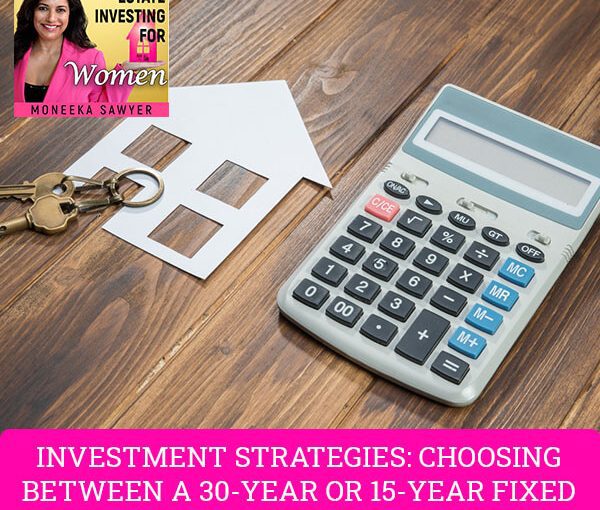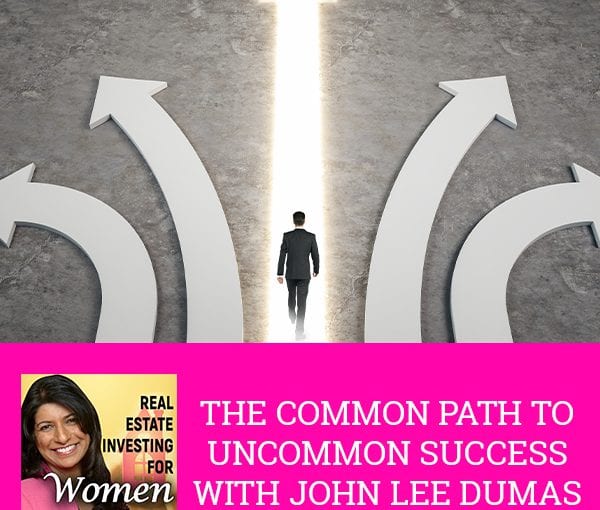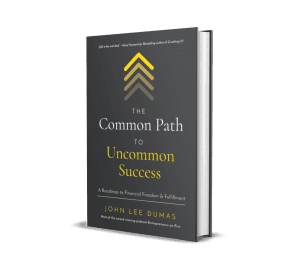Investment Strategies: Choosing Between A 30-Year Or 15-Year Fixed Mortgage With Jen Du Plessis – Real Estate Women
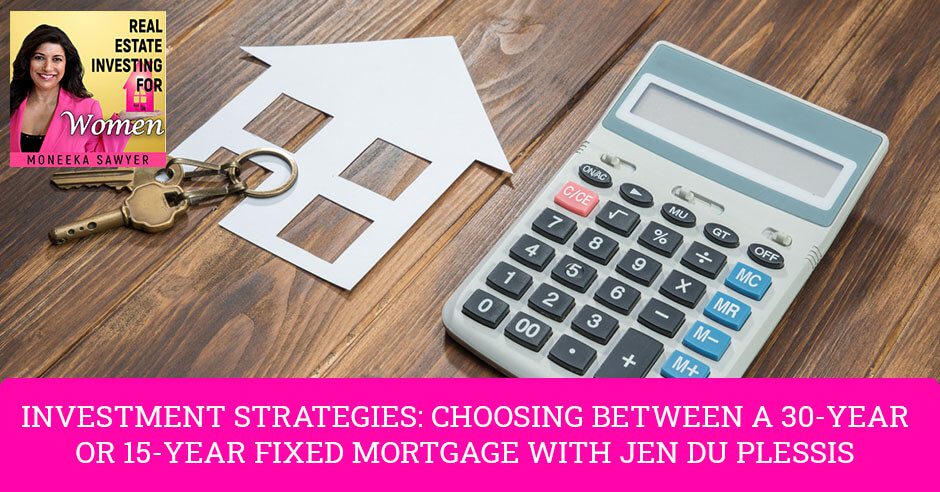
People always ask our guest Jen Du Plessis, whether to decide on a 30 year-fixed or a 15-year fixed mortgage. In this episode, she shares in-depth insights on what to choose and expect. She explains that the factors in your decision should always include analyzing the market opportunities and your life goals. There is no right way for everyone since people have different situations. Listen as Jen discusses the various factors affecting the rates of your investments, mortgages, and business. She also shares critical success strategies to help scale your real estate business. Tune in to know your assets and loans and make the right decisions.
—
Watch the episode here
Listen to the podcast here
Investment Strategies: Choosing Between A 30-Year Or 15-Year Fixed Mortgage With Jen Du Plessis
Real Estate Investing For Women
I am so excited to welcome back to the show, my friend, Jen Du Plessis. She is known as America’s lifestyle mastery mentor. People most attracted to her are high achieving professionals and entrepreneurs who are missing something. Through her mastermind, she helps people increase their awareness of what’s possible and to multiply the results in record time while having the courage to say yes to their personal lives.
She is the CEO and founder of numerous companies. She is from Northern Virginia and attended Colorado State University where she studied Architectural Design and Construction Engineering. She has been married to her high school sweetheart, has two children and three grandchildren. She has been in the financial services industry for many years and was listed in the Top 200 of Nationally Ranked Mortgage Originators and funded over $1 billion in mortgage loans. She is an eight-time #1 Amazon Best-selling Author, host of two top podcasts and a TV show host.
She is an expert in living a life of luxury, priority and time management, business relationships, business scaling, sales management and a certified mastermind facilitator. She is a charismatic speaker. She’s been sharing stages with icons such as Tony Robbins, Les Brown, Darren Hardy, Jeff Hoffman, Sharon Lechter, and many more. She believes that entrepreneurs can live their legacy while building it and it’s time to start living a life of luxury every single day.
—
Jen, welcome back to the show.
It’s so painful to listen to all that. Every time I get introduced, it’s what happens. You have to do it.
It’s so funny because we were in the green room chatting away and I was like, “I’ve got your bio.” She’s like, “No, I’m updated.” It’s so funny because I updated mine too.
We grow. That’s what happens. You have to add stuff.
That’s what we are doing. That’s what we’re supposed to do. We’re supposed to grow. I love that. Thank you. The last time you came on the show, we talked about mortgages and some of that stuff. I want to talk about specifically the 30-year versus the 15-year. I get questions on this all the time about, “Which one should I invest in because the rate is lower? Which one should I get when I do my refinance or purchase because one has a lower rate, but the other one has a lower payment?” I know what I say and my audience knows what I say, but I want to hear what you have to say about that because you’ve been in the industry about that.
When I was originating, I got asked that question all the time and it was funny because people don’t believe that you can customize a 30 or 15-year fixed-rate loan or 20, or 25. I used to have clients call me and say, “What’s your rate,” which is the wrong question to ask. I would say, “What have you been quoted on a 30-year?” They would tell me. I’d say, “Did they tell you about the Super Saver 25?” They’re like, “No.” “All that is a 25-year term. There’s nothing different, but you are a customizing.”
Even the difference between a 30 and a 25, if you look at how the loan pays off, you look on a graph, it’ll pay off sooner, not as much as a 15. There would be a smaller line, but depending on the person’s life goals or the goals that they have, that can be a good strategy for you. If you’re going to be in the house for a shorter period of time because, at any point in time, you have a lesser balance if you want to accelerate that.
The answer to your question is it depends. I used to reply it depends and bring them and go, “What do you think the answer is?” Everybody goes, “It depends.” There is no one strategy that’s good and I don’t think anyone should put their mindset to, “I only do 30-year. I only do-15.” Your life events, the market and the opportunity costs are all going to play a role in the decision that you make on it.
We wanted more return on our money and better ways to invest.
Before we move deeper because I do want to find out about this customizing, I was a mortgage broker for years. I didn’t know about that. I’m excited to hear more about that. The other question is, “What is the rate?” You said, “That’s the wrong question to ask.” What’s the right question to ask?
It’s interesting because the rate is an important factor and this gets down to the customization. I’ll take you back to The Great Recession that we had in 2008. At that time what gave them the momentum for that was that we had all been waiting for some market churn. At the churn of the century, we were all into the dot-coms and leveraging dot-coms and stuff because we wanted more return on our money and we wanted better ways to invest.
What ended up happening is because of dot-com, our eyes were opened and aware of what was happening in investing and in the marketplace and as consumers, all of us, we were hating to open up our 401(k)s every quarter and we’re like, “It’s going to be painful.” I don’t want to go too detailed but into the trenches of the secondary market and everything, loans are sold in pools. On conforming conventional loans or whatever that may be in your area, the standard cookie-cutter conventional loan, if more people are buying that, the pool is larger. It’s like taking all your groceries in at one time. It’s less energy versus 1, 1, 1.
If you have this big pool and you’re selling the big pool and you called the lender and said, “I want 30 or 45 days, 60-day lock.” We’re committing to delivering however many loans are in that pool by that date, otherwise, there are penalties. There’s one loan. It’s going to be more expensive to deliver than if there are 1,000 loans in that. The lender banks on the fact that they’re going to have a plethora of loans in a bigger pool and therefore, the cost of delivery is going to be lower.
You have to know this in order to understand. Back then what happened was, we said, “If you’ve got this big pool of clear water. You can drop one little drop of Coca-Cola in there or coffee and it wouldn’t impact the whole thing.” We as consumers said, “Let’s mix up our investing or mutual funds and stuff like that. Let’s mix them up a little bit and let’s drop even more of this color in.” What ended up happening is it turned color. It got bad because now we had more non-performing and difficult loans into these pools that we thought we would get good returns. We were all living high on the hub because we were like, “Look at this,” as it came in.
What people have to understand is that the rate is very important. I get it. I had been selling a negatively amortizing loan way back in the ’80s and ’90s for nine years. Best performing loan in the marketplace and lowest turnover because no one would refinance because the rate was always better than the market but we got all these brokers who came in and said, “I want that product to. I need to have a mix.” The start rate was one in a quarter.
They didn’t tell you about all the implications that it’s negatively amortizing. The best rate in the world could be a financial disaster. You don’t want to shop for a rate. You want to shop for the terms that fit your financial situation and your life events at that particular moment. It isn’t that there’s a better question. It’s not the only question. A lot of people lead with that and it’s important, but every lender is within an eighth and a quarter, sometimes 3/8 to each other. There are more than 365 lenders in the world and you’re never going to find the best rate every day because it’s all shifting around.
If you call at noon and the market tanks and you’ll call someone at 4:00, then they’re going to have a higher rate than the one you talked to, but when you call them back, they’re going to have the higher rate and vice versa. It’s not about the rate. It’s about who can deliver what your financial goals are or who can help you dissect the DNA. This is why you want to customize it. When I say customizing a 30, 15, 20, 25-year loan, it’s, “Do you want to put 5%, 3% or 0%?” There are different rate options. There are seventeen different things that can affect the interest rate. That’s the customization of interest rate.
When you call and go, “What’s your rate?” “My rate anywhere from 2% to 8%. What’s your deal? What are your terms?” As we talked about on the last show, I do a lot of situational lending. It’s called non-conforming. People will say, “Yeah, but the rates are high.” It’s not that high anymore. There’s not a big spread, but I go, “I understand that the rate is high, however, your situation isn’t fitting into the conforming. You need to understand that.” It’s not about the rate. It’s about who can get you across the finish line with the best terms for your financial situation at that moment.
I was also in the mortgage industry when the NegAms were the biggest thing. There were a lot of people that got killed by the NegAm or they thought they got killed by the NegAm, but the problem is it was because they weren’t educated. I love that you were like, “You need to understand the terms that my rate was 1.25%, but at that rate, it’s negatively amortizing.” Those NegAms all had a rate where you were not negatively amortized. They pay that. There were four options.
When you’re looking at that, all of my clients that did the NegAm, equity were going crazy here in the Bay Area. A NegAm made sense, but then as the market turned, they started to pay so that now they were paying their minimum in order to not NegAm so that they could wait for the properties to recover because we also took a huge dive as far as equity. Instead of getting called on those loans, they adjusted their payment. What happened with a lot of people is they ended up getting called on those loans because they didn’t understand that they could make a different payment.

Investment Strategies: There is no one strategy that’s good because your life events, market, opportunity costs are all going to play a role in the decision that you make on it.
That’s a consumer issue because we lack the financial education to understand how those work, but it’s more in the hands of the lender. You go to Bob and wherever Bob works and he manages your assets. It’s Bob’s job to call you and say, “That stock we were in, it’s going down.” We all experience this. We don’t get a call from Bob. We find out when we get our statement. “Why didn’t you call me, Bob?” The same thing happens with your CPA. They go, “You owe $30,000 in taxes.” You’re like, “If you had told me at month six to make some adjustments, I would have made adjustments.” This is a huge failure in the financial services industry and it includes lenders.
I don’t care if you’re in a 30-year fixed rate or if you’re on a NegAm loan, we need to be able to manage and help guide clients. That’s what I coach on for loan officers is having those mortgages under management. I used to say, “If you’ve been orphaned by your last lender, I’d like to adopt your loan.” They all left at the end of 2008. It’s dropping off like flies and these people were crying. They had negative equity and not because of NegAms loans, but because of other things. They didn’t know who to turn to. I said, “I’ll adopt your mortgage. I’ll be the Bob who helps you go through this.”
We had emotional refinances on 30-year fixed-rate loans, which is interesting because you had said, that adjustment, you could make the minimum payment, the interest-only, the 30-year and the 15-year payment. The people go for the low payment. It’s like your credit cards. Why do you go for the low payment? You know if pay more, it’ll pay off. If you don’t, you’re meeting the interest. That’s it and not even all of it.
If you do the minimum payment, it’s NegAm.
It’s the same exact thing. The only difference is it’s not on an appreciating asset. Be thankful that you have that on your mortgage. We did an emotional refinance on a 30-year fixed because people would say, “I’m not going to make any payments.” I go, “Hold on.” I had a guy call me once and he said, “For the last several years, I’ve been making an extra $100 payment on my mortgage.” He was not my client until I had this phone call.
He said, “All that adds up $1,200 a year times seven years.” Wouldn’t the lender give me that credit and allow me not to make the payment now, since I lost my job? “No. If you had put that $100 in the bank, you could draw from it and make your payment while you’re looking for a job, then you could refinance, but now you haven’t made your payment and you don’t have a job. I can’t help you.”
These are the discussions. It was so funny because I had a little bottle of pink Pepto-Bismol, a box of tissues, a bottle of wine, and I said, “Pick your poison because this is going to be a painful conversation.” If I could do an emotional refinance to help them strategize on how they’re going to get out of it if the market isn’t going to give it to them, that’s huge. On 30 and 15-year mortgages, it doesn’t matter. The customization is, “Do you want to put 5% or 20%? Do you know when you put 20% down, your rates are higher than if you put 19.99% down?”
I did not know that.
People don’t see it. They’re all going to put 20% down. I don’t want that private mortgage insurance. That would give you a lower interest rate. You have to ask these questions. You have to figure them out. One of my specialties was investors. With investors, people would come to me and say, “I want a 30-year fixed because I want the lowest payment.” They want cashflow. The problem is as investors, we’re doing the same thing.
When we make that transition from an owner-occupied homeowner to an investor, you have to take the emotion out of it. It’s about the numbers. When we go to a 30-year fixed-rate loan, while you may have the cashflow, you’re also not paying down the balance on your loan. We’re only looking at cashflow. We’re going to buy for cashflow or appreciation. It amazes me. I would tell people, I’d run these numbers all the time, “What if we did a fifteen-year and an investment?”
People are like, “I got my cashflow.” I remember running one of these negative cashflows. It was $275 a month. He said, “That’s not why I’m buying the property.” I said, “You’re buying the property for appreciation, so we’re going to go for negative cashflow.” “I can’t pay $275 negative cashflow on an appreciating asset that gives me a tax deduction, but I can pay $700 on a car.” While you have a job, this is a strategy. This is why I say it’s all customized. If you didn’t have a job and you were solely relying on that income, then we would put you in a 30-year, so you have the cashflow.
It’s not about the rate; it’s about who can deliver what your financial goals are.
While you have a job and you can afford $275 negative cashflow, let’s accelerate the payoff and let’s use these first two properties as jumping things to your next property. In that same five-year timeframe that you would own the house, one, when you’ll sell it and have had cashflow. The other, you will sell it and have more equity to take those two properties and go buy that one property and go buy two. Now, we’ll put you in the 30-year. That’s called step investing and people don’t see that.
It’s how Brian and I were able to exponentially increase our portfolios because we would take one, hold it, sell it and buy two. The next one we would buy normal and the next one we would buy fifteen-year term, hold it, sell it and buy two more. That’s why for the investor side of things, there’s a great difference between a 30, 15 or a 20, whatever you know is comfortable, but we jump into these crazy 30-year terms because we think it’s the safety, but we’re not going to have the loan that long anyway.
That’s true because most of us refinance.
That’s a NegAm loan. Every time you refinance, you rob yourself of equity because you roll the closing costs in. It’s not about the rate. It’s about the strategy you need to be looking for and how long you think you’re going to have the house and the loan.
What you guys do is you get a house, you take a fifteen-year loan, pay it down, you sell it and then with that equity now or whatever you get from that, you use that and you buy two. The next one you buy on a fifteen and those two, you finance on a 30 because you’re going to hold them longer. You buy another on a 30.
The two houses that I bought, one will be on a 30 and one would be on a 15. That fifteen, I will sell in five years and buy two more.
To explain what happens when you’re amortizing loans on a 30-year, in the first ten years, it’s basically all interest. You get this great write-off but you’re not paying down your principal at all.
You’re at 21 when the streams cross.
Those first ten years are all interests. When you’re in a fifteen-year, you’re paying down more principle, which is why her equity is growing. You’re paying it down. Your equity is growing because the property or asset is appreciating. You’re also paying down the principal. When do those lines cross on a fifteen?
It’s at year nine.
It’s a lot sooner. That’s why she’s doing it that way. She’s got one that she’s holding, one that she’s paying down so that she’s building equity so that she can buy another piece of property.
Instead of trying to save 20% down every single time for investors. At the time, I was doing 10% down for investors because that’s what you could do. That was to my benefit too, but again, this is why your lender is so important to you and why, “What’s your rate,” doesn’t work. Whether it’s owner-occupied and an investor that doesn’t work. You have to talk about the strategy.

Investment Strategies: It’s not about the rate; it’s about who can get you across the finish line with the best terms for your financial situation at that moment.
I call it the EHE strategy. “What’s your Entrance, Holding, and Exit strategy for everything?” We know as investors, we’re always going to have an entrance, holding and exit strategy, but we don’t think about that on owner-occupied. That’s important given what the long haul looks like. It’s not enough to find a good low rate.
You and I had talked about it too is the rate on a 15-year is lower than on a 30 because the investors can’t predict 30 years out. It might be a good loan. They don’t want those low-interest-rate loans on their books. Especially now, with inflation, everybody who refi’d in 2021, they don’t want those loans on their books. They want to get them out because they’re not making as much money as the inflation side. With new loans, they are, but you get a lower interest rate on a fifteen-year loan. More of your payment goes to the principal than to interest on a fifteen loan, so it pays off more. Less of the payment goes to interest on a 30-year loan.
If you’re going to commit to a fifteen-year loan, you’re committing to that loan. You and I talked about this in the green room. It’s better sometimes to get a 30-year loan and pay it as a fifteen anytime you want because no loans have prepayment penalties. You can pay at any time you want. Annually or monthly, it doesn’t matter. I would say, “Put your money someplace else and make lump-sum payments if that’s what you want,” because there’s no obligation to pay it.
What is your equity growing at? You can’t cut a piece of your drywall and walk into the bank and say, “I’d like some more of my equity back.” That doesn’t happen. I’d rather retain my equity in the form of cash in my bank account, but there are opportunity costs too. You’re paying more and accelerating the principal reduction for whatever reason you have. I would challenge people, “Why do you want to own your house free and clear? Is it because you don’t have any tax benefits?” Even in my house now, I have a little over $750,000 of equity sitting in my house and it’s killing me.
It’s because it’s dead money.
It’s sitting there and I hate it because we were going to move, but my husband had a medical thing and now we can’t. We got to sit here, but it drives me crazy. There’s no benefit whatsoever to having all that equity in there, but you could reduce the equity if the interest is lower. If you took a 30-year fixed rate and the interest is higher, you have a lesser payment, you could divert that money that you would have paid on the fifteen to something else.
You could divert it to paying off debt, non-preferred high-interest rate debt that’s not tax-deductible. You could divert it to funding your child’s student loans or education. You could do what you and I do. We get capital and then we seek around and try to find another place to invest our money. That’s opportunity costs. If you get a fifteen-year loan, because you want equity, you’re missing out on opportunities to be able to create other cashflows passive income.
Think about the Delta about that. What right now is the rate of a fifteen-year?
I don’t know what the rate of a fifteen-year because I’m not in the market anymore, but I’d say it’s probably 3.25% or something like that.
Your Delta is 3.25%. You’re paying 3.25% more so you have cash available to you so you can make another investment.
To get a 30% return.
As investors, we’re always going to have an entrance folding and exit strategy.
Even if you get an 8% return, is it worth it to you to use that cash to make 4%, 5%, 10%, 50%, 30% or whatever? It gives you the flexibility that we went through COVID. How many people were like, “I can’t afford my mortgage.” If you’re on a fifteen-year and your payment is higher, you have to pay that higher payment. If you’ve got a lower payment because you’ve got a 30-year, you only pay that 30-year payment. When times are flushed, you’re welcome to pay down that 30-year if you want to.
You can put it in a bank or invest it over.
That’s why I recommend always to get a 30-year because it gives you so much more cash flexibility because I’ve seen 2001, 2008, 2019, 2020 and 2021 come. We’ve suffered financially and it’s a bit of a security blanket not for rate, but for payment.
It’s always about the payment. What we were talking about in the green room is there are life events that happen to all of us. During COVID, people got divorced, passed away, or got married. There are life events that depict whether you should be doing a 30 or 15. Whether you should pay points or not. whether you should roll in your closing costs or not or you should escrow or not. All of those seventeen different factors have to be looked at every single time and not because they need to be looked at to get you the lowest rate. You want the lowest rate, I get that. I want it to, but the lowest rate for your terms for the things that you want.
For example, people don’t realize that it costs extra money at closing to waive escrows. People don’t understand that. The reason you don’t understand that is because if you don’t pay your taxes on your own, you don’t pay them. They become the first position and the lender could lose the entire principal balance of your mortgage if you don’t pay your taxes and it gets turned over to someone like me who buys tax liens. I’ll buy a tax lien for $5,000 and I get a $300,000, $400,000 house free and clear because the first mortgage is beneath that. It’s more of a risk on the lender side that you’re going to be capable of striking that check in a timely fashion to not hurt their equity or collateral.
That’s why they want to EMP out.
All of this depicts what your circumstances are. Don’t lead with rate, get the whole gamut.
Go to somebody who understands. This is why we talk about this all the time. When you’re going to a lender, you want someone who understands investing because the conversation is different for investing than it is for a primary residence. It’s significantly different because the package is different. The goals are different. How long are you going to hold that loan is different? There are a lot of different things. Those are the basic things and things we don’t even know to ask or we do know to ask, but there’s a lot that we don’t know what to ask. Your lender will help you through that.
Even if it’s owner-occupied, you need to be taking this strategy and this outlook. You don’t want order takers. You don’t want to call Quicken Loans because they’re not going to do anything to help you. They’re order takers and are there to give you the lowest rate. If you go on Quicken or Rocket Pro go and immediately, they’re on you like, “Do you want to talk?”
You see a great rate. If you scroll all the way down, you’ll find out that you have to put 25% down and it costs three points to get it. If you have a $100,000 loan, that’s $3,000. If you have a $300,000 loan, that’s $9,000 to buy that rate, which may be your strategy, but most people don’t have 25% down and three points on an owner-occupied.
Could you tell me a little bit about doing a 20-year or 25-year loan? I know that they’re out there. I don’t know how to get them and I was a mortgage broker.

Investment Strategies: It’s not about the rate. It’s about the strategy you need to be looking for and how long you think you’re going to have the house and the loan.
All you have to do is ask because there’s pricing available for 20, 25, and 30-year loans. Fifteen and below is going to be one price or the same price. Anything above that is going to fit into the category of a 30-year fixed-rate loan and there might be a slight advantage. It’s a little yin and yang that goes on because like a 30-year with 20% down would be X price. A 25 would probably be the same price, but if you put another five down, you might get a better price and then it depends on the day or market.
All of this adjust moment by moment, all day long as stocks are trading. This is exactly what is happening with the market. If you have a phone call with someone at 10:00 in the morning, that’s yesterday’s rate. If you have a call with someone at 11:30 or 12:00, that’s this day’s rates as they were released and good luck the rest of the day because they could be adjusting all day long. This is why you’re never going to find the best rate in the market. You’re going to have to find what works for you.
We were talking about you sell the loans in buckets to Fannie and Freddie or whatever. When you’re trying to get a specialized or customized loan at 25 or 20 years, doesn’t that take it out of the bucket?
No, it’s still sold in the 30-year pool. It’s still the same strategy.
It’s amortized differently.
What makes it different is that it’s the loan amounts. It is not the points you paid or whatever. They’re sold based on the loan amounts. This is interesting because it’s a question that I ask the loan officers and realtors all the time and you wouldn’t believe how many can’t answer the question. This is scary. As consumers, you want to be able to answer it. “Why is the interest rate higher on a $1 million loan than it is on a $400,000 loan?” What do you think the answer is? We’ll put you on the spot. Not because you were a lender or anything. This is what consumers do is risk and it’s not. That is not the right answer.
For example, a $400,000 loan has someone who’s putting 5% down is squeaking by with credit, is squeaking by with qualifying ratios. It is getting a gift. He probably has some job changing and hopping. He has high debt. We’re using all their money. Maybe they’re even getting a 401(k) or all of that. That’s less risky than someone who puts down 35% on a $1.2 million home.
My husband and I have this conversation all the time. We can afford a $1 million loan. Why are we getting hassled when someone who can’t afford the $200,000 loan is not? I get what you’re talking about.
The reason is the pool. There are fewer people buying that high of things. The pool is always smaller. The price across the sale of the pool is higher. It’s not a risk at all.
That’s so fascinating. Thank you for that. I love that. Now, we know.
That’s why when you go to a bank and they have a portfolio loan, they have something that says, “We can do something unique and different as a portfolio.” It’s a higher price because it’s not even sold in a pool. They’re taking on the risk on its whole. They’re shelving the loan and they’re not selling it. That’s why when we get to situational lending, this non-QM or non-qualified mortgage, non-standard Fannie, Freddie, FHA and VA. We start getting into non-QM, the rates are a little bit higher because you’re asking them to take on a riskier situation.
Every day is a choice. You can choose to be successful.
A situation where they can’t sell it in the secondary market or now, we can. We can sell in the secondary market, but again, the pools are smaller because fewer people are coming into that. I call it situational lending, which is the name of my mortgage company, Situational Lending because your situation depicts what the price is.
Tell everybody how they can reach you.
The best way is you can go to JenDuPlessis.com and send me a message or something and I’ll be happy to respond to you. You can text Make Your Mark to 26786 so you can get some preliminary information about what I’m doing. I hold very high-end masterminds that are for people who are highly successful and are missing something in their lives. What I’m here to do is guide you in that facet, mortgages and on business. I don’t coach anybody. It’s a mastermind. We have some personal breakthroughs too. It includes a high-end retreat. I believe that mindset plus mechanics creates momentum. You can’t have one and create momentum. You have to have both.
You can text 26786. The thing you’re going to text is Make Your Mark. It will go through even though it’s not a normal phone number. It’s all set up that way. What are we going to be talking about in EXTRA? We’re going to be talking about priority management. This is one of the things that Jen does better than anybody else. She runs all these companies.
She still has time for vacations, spend time with her husband and her grandkids, and all the things that she loves to do, but she also runs all these businesses. She does a good job of priority management. I want her to share some of her magic and wisdom around that. We’re going to do that in EXTRA, so stay tuned for that. Before we move into EXTRA, here are three rapid-fire questions. Tell us one super tip on getting started investing in real estate.
Get educated. Go talk to several lenders and find out who has, what specialty, where, everybody has a niche and expertise. Make sure that you go to the person who has. Don’t go to your buddy, grandma, sister or grandchild. Go and talk about what their expertise is in any type of investing.
What is one strategy for being a successful real estate investor?
Sometimes we assume things. We get contracts in and we go, “I’ve seen that contract.” Don’t. Look deep into those. I would say that strategy is to get yourself comfortable with looking at contracts and looking at terms, etc. Ask some title companies or escrow companies around you if you could look at investor contracts. They can mark out all the people and all that good stuff just so you get a feel of what it looks like because that first one that comes in is scary.
You feel so much more confident making offers and doing deals if you’ve got some depth of knowledge inside of you that you can count on. It gives you more confidence.
Even with me when dealing with our Buyers Club, the first time I got the contract in I was like, “This is foreign to me.” I’m not going to make assumptions that they know what they’re doing so I’m going to challenge everything on there to make sure that I clearly understand.

Investment Strategies: Get yourself comfortable with looking at contracts and looking at terms. Ask some title companies around you.
What would you say is one daily practice that you do that contributes to your personal success?
For lack of a better word, get your head on straight. Get a checkup from the neck up every morning. Meditation, prayer and all those good habits that you have in the morning. Every day is a choice. You can choose to be successful or you can choose to let the day slip by. I choose to be successful and the only way to do that is to reformat myself every day. Recalibrate every single day.
This has been phenomenal. Thank you so much for everything you’ve offered on the show, Jen.
Thank you so much. I sure appreciate it. I always love talking to you, Moneeka.
Thank you for joining Jen and I for this portion of the show. We do have more so stay tuned for EXTRA. We’re going to be talking about priority management. If you would like to subscribe to EXTRA, go to RealEstateInvestingForWomenEXTRA.com. The first seven days are for free. Go check it out. For those of you that are leaving Jen and I now, thank you so much for joining us. I appreciate you. I look forward to seeing you next time and until then remember, goals without action are dreams. Get out there, take action and create a life your heart deeply desires.
About Jen Du Plessis
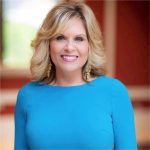
Jen Du Plessis, America’s Mortgage Mastery Mentor helps mortgage loan officers and real estate agents who are overwhelmed, stressed out, and sabotaging their personal lives for the sake of their business to multiply results in record time and have the courage to say yes to their personal lives (which sometimes means saying no to clients).
During fifteen of her 37-year career in the mortgage industry, Jen has been listed in the top 1% of loan officers nationwide; spending 3 years in the top 200 of nationally ranked originators, and has funded over $1 Billion in mortgage loans. She is recognized as an Influencer in her industry as the best-selling author of LAUNCH-How to Take Your Business to New Heights, top podcast host of Mortgage Lending Mastery, and highly sought out and charismatic speaker; speaking on stages with such icons as Darren Hardy, Tony Robbins, and Les Brown.
Today Jen is passionate about empowering mortgage loan officers to achieve professional and personal breakthroughs so that they stop the daily chaos by identifying their priorities to gain calm to take back control of their business and life. She is guiding her coaching students to attract clients rather than chasing them. And lastly, she is devoted to helping each student’s business grow exponentially rather than hitting the reset button to have the same results year-after-year.
She has been seen and heard on Good Morning America, Sirius/XM Radio, Voice America, and Mortgage News Network. Jen has been featured in publications such as The Wall Street Journal and The Washington Post; is a regular contributor to Mortgage Executive Magazine and Mortgage Women Magazine and has been recognized with the Women with Vision Award as one of the Top Women in the Mortgage Industry.
______________________________________
To listen to the EXTRA portion of this show go to RealEstateInvestingForWomenExtra.com
To see this program in video:
Search on Roku for Real Estate Investing 4 Women or go to this link: https://blissfulinvestor.com/biroku
On YouTube go to Real Estate Investing for Women
Moneeka Sawyer is often described as one of the most blissful people you will ever meet. She has been investing in Real Estate for over 20 years, so has been through all the different cycles of the market. Still, she has turned $10,000 into over $5,000,000, working only 5-10 hours per MONTH with very little stress.
While building her multi-million dollar business, she has traveled to over 55 countries, dances every single day, supports causes that are important to her, and spends lots of time with her husband of over 20 years.
She is the international best-selling author of the multiple award-winning books “Choose Bliss: The Power and Practice of Joy and Contentment” and “Real Estate Investing for Women: Expert Conversations to Increase Wealth and Happiness the Blissful Way.”
Moneeka has been featured on stages including Carnegie Hall and Nasdaq, radio, podcasts such as Achieve Your Goals with Hal Elrod, and TV stations including ABC, CBS, FOX, and the CW, impacting over 150 million people.
The Common Path to Uncommon Success with John Lee Dumas – Real Estate for Women
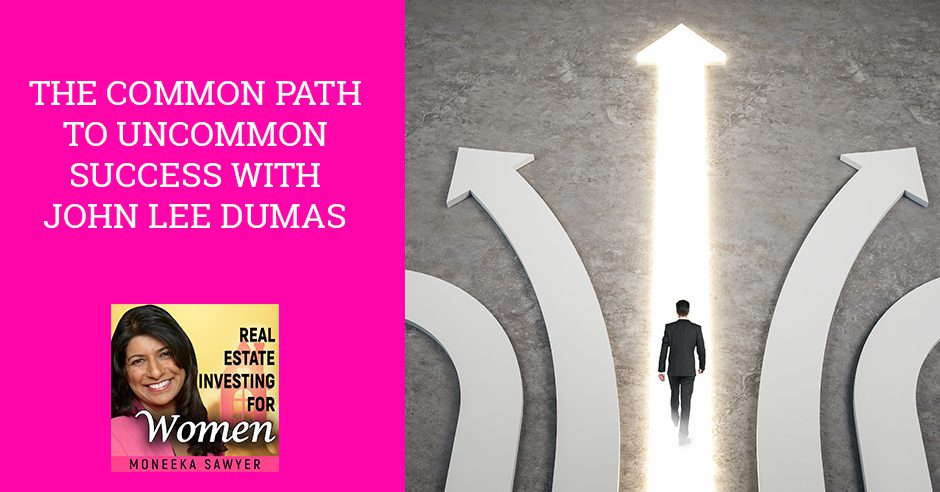
The path to success is not hidden; it’s well-known and well-worn. You simply need a roadmap to help you get there more quickly. This is the message of The Common Path to Uncommon Success, the first traditionally published book by John Lee Dumas, founder and host of the award-winning show, Entrepreneurs on Fire. John’s book is a seventeen-step roadmap to achieving financial freedom and fulfillment in your life. Want to get more glimpses of the book? Listen in to his comeback chat with Moneeka Sawyer so you, too, can learn how to walk the common path to uncommon success!
—
Listen to the podcast here
The Common Path to Uncommon Success with John Lee Dumas – Real Estate for Women
Real Estate Investing For Women
I am so excited to welcome you back to the show John Lee Dumas. He is the Founder and host of the award-winning show, Entrepreneurs on Fire. With over one million monthly listeners and seven figures of annual income, JLD is spreading entrepreneurial fire on a global scale. His first traditionally published book, The Common Path to Uncommon Success, is available now for pre-order at UncommonSuccessBook.com. John, welcome back to the show. How are you?
Moneeka, I am fired up. Your energy is next level. I love your laugh. I’m so happy to be here.
I asked you to come back to the show because I’m excited about your new book, the title is?
The Common Path to Uncommon Success: A Roadmap to Financial Freedom and Fulfillment.
The reason that I brought you back, I want to tell a quick story. When I was sixteen, I was a foreign exchange student in India. I remember going to the book markets. One day, I bought four books that changed my life. There was Think and Grow Rich by Napoleon Hill, How to Win Friends & Influence People by Dale Carnegie and The Power of Positive Thinking by Norman Vincent Peale. There is a secret book that I’ll tell you about later. Anyways, those books started my journey towards personal development and the idea of being in business for yourself.
The path to success is hard work, but it's a very common path. It's not complicated, hidden, or scary. Share on XNow, when I go back to read them, they feel very old school. I’ve been looking for the newer versions of these books to re-motivate and re-inspire me. What I love is with Think and Grow Rich, it was all about Napoleon Hill doing interviews. You are like the interview guy. You have interviewed thousands and thousands of super successful people. It’s like the next level. That’s why I’m so excited about talking about this book. Thanks for coming on. What I want to start with is, tell us why you think people have been lied to by experts out there in the business world.
This is the reality. There are amazing experts out there in this world. You just named a number of those authors who are spreading amazing, great content and helping so many people. At the same time, there are some so-called experts who aren’t quite doing that. Here’s where the red flag comes in. When you hear somebody tell you that, “The path to success is secret, hidden, and complicated, but I have the key to your success. For $1,997.97, I’ll unlock that key for you.” That is a red flag. I’ve interviewed over 3,000 successful entrepreneurs. I personally have been a successful entrepreneur for almost a decade now. I’ve been running a multimillion-dollar a year business for several years.
I know that the path to success is hard work, but it’s a very common path. It’s not complicated, hidden and scary. It’s a common path to get to your version of uncommon success. I am passionate about letting people know what that path is. That’s why I wrote this book. I sat down and said, “I’ve interviewed over 3,000 successful entrepreneurs. What are the commonalities that all of these entrepreneurs share with each other?” When I boiled it down, there were seventeen core foundational principles that every successful entrepreneur share with each other.
I decided to say, “This is a step-by-step roadmap to financial freedom and fulfillment.” I put it in chronological order and created this book, The Common Path to Uncommon Success. It is that seventeen-step roadmap to financial freedom and fulfillment. I wrote every single word, 71,000 words, 273 pages. It took me 480 writing hours. I did it and I’m proud of it. I want to get this book into your hands so that you can have the gift of financial freedom and fulfillment so that you can have the gift of living your version of uncommon success.
Tell us a little bit about what we’re going to find in this book that I’m comparing it to. Think and Grow Rich was more about philosophy. My understanding is that yours is more about strategy. Is that true?
It’s 100%. There are enough books about motivation and inspiration out there. There are fantastic books. That’s not what this book is. This book is a step-by-step strategic book. This book has every single step in the process that you need to achieve financial freedom and fulfillment. You’ve got to put in the work. It’s going to be hard. It was hard for me launching this business and putting in the work to make this happen. Every one of the 3,000 entrepreneurs that I’ve interviewed has had to put in hard work. What’s also hard is being broke, living paycheck to paycheck, waking up every morning being miserable, going to a job that you hate. That’s hard too. Why don’t you choose your hard? Why don’t you choose which hard you’re going to choose? If you don’t choose this hard of building a business, you’re choosing the other hard by default, which is living a life that’s less than you’re capable of living. Potentially, miserable, broke, and living paycheck to paycheck. You don’t need to choose that hard. You can choose your hard. This is the book that will get you there. This is the seventeen-step roadmap.

Uncommon Success: If you don’t choose the challenge of building a business, you’re choosing the other option by default, which is living a life that’s less than you’re capable of living.
I know on your show I mentioned this quote. I love saying this quote all the time. My dad, when I was 21, shared with me something that completely changed my life. He said, “Everybody has stress, fear, and money problems. Do you want poor people money problems or rich people money problems?”
I got a money problem, but the rich people money problems.
They’re good money problems, aren’t they?
Yes, they are. They’re still problems. They’re better than the alternative.
This is the same thing with success. There’s a lack of success problems and successful people problems. On this show, I don’t talk about life being hard. We talk about life being blissful. Part of being blissful is being willing to put in the work to make your life what you want it to be. If it’s hard work, for me, I love to work hard when I’m super passionate about something.
By the way, Moneeka, that brings up a good point because that’s exactly what step one, chapter one is. Most people will never identify this in their life. What is that? Their big idea. Your big idea is buried within you. We need to take it out. It’s your big idea and zone of fire. You can live in that zone of fire every single day. Like Moneeka said, you wake up and you’re still going to work hard. You’re going to work hard doing something you love, you’re passionate about, that fires you up and lights you on fire. If you’re going to work hard either way, why not it be something that is your big idea, your zone of fire? That is what step one, chapter one is, identifying not Moneeka or JLD’s big idea, not being a pale, weak imitation of somebody else’s big idea, but your big idea. There’s a big idea inside of all of us. Let’s get it out.
Tell us a little bit more about what we’re going to find.
Let’s move on to chapter two. This is the thing that a lot of people are surprised at. They come up with their big idea. They’re excited and they should be. It’s a big idea. It’s a good idea, but other people have had this good idea. There’s a lot of people in this world. It’s a good thing that other people have had your big idea before because that’s proof of concept. That means that your big idea is a great idea. It’s viable. That’s awesome. You can’t though, now with this entrenched competition out there, go like a lamb to the slaughter and enter into the market of where your big idea is. You will get crushed. What you need to do is get initial momentum and traction. How you do that is step two, discover your niche.
You need to find the void in the marketplace that’s not being filled and fill that void. You need to find the place in the marketplace that’s not being served and serve it to the best of your ability. By the way, you should become the best solution to that one, single niche problem. I teach you how to do that in step two so that you don’t go out and get walloped by all the competition out there in this broad, vague idea of yours that’s a good one. We’ve got to start small and then we plant a seed. We crank a little wedge in there and then we crank it out.
My big idea was a podcast. I did niche down to business podcast. I did niche down again to interview business podcasts of entrepreneurs. I did niche down a fourth time to daily podcast interviewing entrepreneurs. I did niche and became the best daily podcast interviewing entrepreneurs. By the way, I was also the worst because I was the only daily podcast interviewing entrepreneurs, where sometimes you have to do. I got my initial momentum and traction, wedged in there. What have I done over the years? I’ve blown up and created a media empire as a result. You can, too.

Uncommon Success: If you’re going to work hard either way, why not it be something that is your big idea, your zone of fire?
Is this book for everybody?
This book is not for the people who want to become filthy rich. There are people like that who are out there. I’m not saying you’re going in the wrong direction there. If that’s your heart’s desire, go after that. This book is not about how to become filthy rich. This book is about how to become financially free and fulfilled simultaneously. Those two things are so important in my opinion. I’m teaching people how to become financially free and fulfilled. That might also equate to making millions of dollars. It might equate to be making hundreds of thousands of dollars.
I have a friend, by the way, to give you the alternate example, who’s living in Bozeman, Montana making $47,000 a year. This guy lives well below his means. He wakes up every single day, does exactly what he wants to do, and loves his work. He is so obsessed with fishing and hiking. He gets to do that with his dog and all this. He is so financially free because he’s smart with his money and lives below his means. He’s fulfilled because he’s doing what he loves. That’s a win. I’m a win. I make millions of dollars a year. I’m financially free and fulfilled because I’m doing what I love. You can have both ends of the spectrum. There’s not a right or wrong answer. This book is for people who want that latter, financial freedom and fulfillment, not just becoming filthy rich. I don’t know what that is. I don’t know how to do that because I don’t want that.
Your personal big idea is buried within you. It's your big idea and zone of fire. Share on XInstead of filthy rich, blissfully rich. That’s more about without having the whole picture and puzzle. Thank you so much for joining us, John, and sharing with us your book and information. I’ve already got my copy coming. I’m so excited about that. Ladies, thank you so much for joining John and I for this show. I hope you found it as incredibly exciting as I did. I look forward to seeing you next time. Until then, remember, goals without action are just dreams. Get out there, take action and create the life your heart deeply desires.
Important Links
- Entrepreneurs on Fire
- The Common Path to Uncommon Success
- Think and Grow Rich
- How to Win Friends & Influence People
- The Power of Positive Thinking
About John Lee Dumas
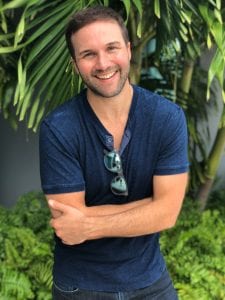
John Lee Dumas (JLD) is the founder and host of the award-winning podcast, Entrepreneurs on Fire.
JLD has interviewed over 3,000 of the world’s most successful entrepreneurs on his award-winning podcast Entrepreneurs On Fire, which has amassed over 100,000,000 listens and 3,000 5-star reviews since its launch in 2012. Past guests include Tony Robbins, Barbara Corcoran, and Gary Vaynerchuk.
JLD has spent the last 8 years studying and interacting with those who have reached the summit of business success, and he has created a 17-step roadmap that will guide YOU to financial freedom and fulfillment.
Love the show? Subscribe, rate, review, and share!
______________________________________
To listen to the EXTRA portion of this show go to RealEstateInvestingForWomenExtra.com
To see this program in video:
Search on Roku for Real Estate Investing 4 Women or go to this link: https://blissfulinvestor.com/biroku
On YouTube go to Real Estate Investing for Women
Moneeka Sawyer is often described as one of the most blissful people you will ever meet. She has been investing in Real Estate for over 20 years, so has been through all the different cycles of the market. Still, she has turned $10,000 into over $5,000,000, working only 5-10 hours per MONTH with very little stress.
While building her multi-million dollar business, she has traveled to over 55 countries, dances every single day, supports causes that are important to her, and spends lots of time with her husband of over 20 years.
She is the international best-selling author of the multiple award-winning books “Choose Bliss: The Power and Practice of Joy and Contentment” and “Real Estate Investing for Women: Expert Conversations to Increase Wealth and Happiness the Blissful Way.”
Moneeka has been featured on stages including Carnegie Hall and Nasdaq, radio, podcasts such as Achieve Your Goals with Hal Elrod, and TV stations including ABC, CBS, FOX, and the CW, impacting over 150 million people.

